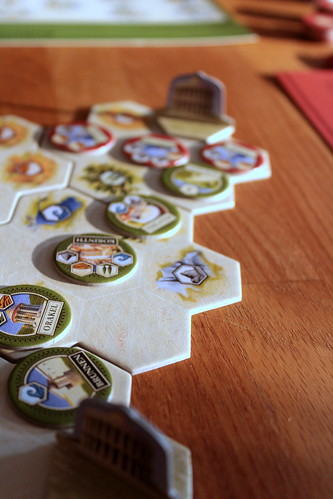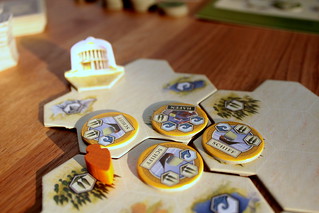So let’s talk about Greece. Don’t worry, this is not about money, and only vaguely about politics. No, Attika dates back a little longer, in terms of the game’s release in 2003, but particularly in terms of the game’s setting.
In Attika, each of the 2-4 players represent an important city-state from classic Hellenic history – Athens, Corinth, Sparta and Thebes. As such, the players try to develop their culture. And, spoiler alert, it is a rare specimen of a game without money or victory points!

In the game developed by Marcel-André Casasola Merkle, each player has 30 buildings of his color, arranged in seven construction / development complexes. The most obvious aim of the players is to place its building tiles on the landscapes of Hellas in a sensible (stay tuned for more) way, and as quickly a possible, as the standard (=most common) game-ending condition is one player having placed all buildings on the board, said player taking the laurels.
By this condition alone, Attika would be pretty boring after a few games, once an ideal building sequence has been determined. However, there are quite a few elements avoiding this:
1 | Buildings
Players don’t have all tiles available at game start. In fact, they start with only four random tiles. And by random, we mean ‘pretty random’. We already touched upon the fact, that the 30 buildings are divided into seven complexes, and there is a sensible way to build them.
Of the seven building complexes, six come with a ‘start building’ (the lone exception is Streets, but more on that later). Complexes range from small (two buildings, like vine-making or silver-minting) to the most extensive cultural complex including ten tiles.
As part of pre-game preparations, each player separates the start building tiles from the others, shuffles them and creates four face-down stacks (one with six start buildings, three with the remaining 24 tiles). Now, the player draws the top tile from each stack, and puts them onto the designated spot on their player board. On the topic of player boards…

2 | Player options
Upon their turn in the game, players have two basic options.
Option one is the option of drawing two face-down-tiles and building them onto one hex of the game board. Since this involves building costs, and since players may not want to place that particular building at that point, players may not be able or willing to build the tile. The alternative is to put the building face-up onto the player board for later use.
Option Two is said later use, when instead of drawing face-down tiles, players can build up to three buildings on the game board from their player boards.
3 | Sensible building costs
One key reason why delaying the building of a certain tiles makes sense is the aforementioned sensible building sequence. Within the different building complexes, there is a logical sequence of urban development indicated by the arrows on the player boards. If you follow this sequence, i.e. you place a tile on the game board next to the tile which precedes it on your player board, you build it for free! So yes, you really want that!
Another bonus connected with the building complexes are Amphoras. You get one of these little treasures for finishing one building complex by placing all of its tiles in one group on the game board. Once you have an Amphora, you can use it to extend your turn once (allowing you to turn a third face-down tile or build an extra tile from your player board).
4 | Game board extension
The game board starts with a modest size so players are pretty much forced into a competition for building space initially. In order to allow players sufficient space to expand, further pieces are added later on. Whenever a player takes the final tile from a face-down stack, that player adds another element to game board at a place of their choice. Ran out of space to complete that complex? No worries, we can fix that!
5 | Game end
The game ends upon one player placing their final tile on the game board, or by connecting two of the sanctuaries on the game board with his or her buildings. If you have not read anything about sanctuaries above it is because this is their only relevance in the game. They sit in the corners of Greece, waiting to be connected.

6 | So what’s the deal…?
Attika is a great pastime which combines a good deal of strategic thinking with some luck (courtesy of the sequence of tiles as well as the resources you draw). But you have plenty of influence over your own fate, as well as interaction with the others by virtue of limiting building space. Often under-appreciated, even a vague threat of connecting two sanctuaries often prompts the other players to deviate from their initial strategies to block your way quickly.Plus, once you have Amphoras at your disposal, extending your turn at an opportune moment can change the complexion of the game in a variety of ways.
Attika will never reach the strategic depths of more elaborate world-building games, but thanks to its good speed and thus limited downtime, it is a light yet well-balanced strategy game with easily enough variation to be addictive. The fact that the game works equally well in 2, 3 and 4 players without major changes to the game characteristics is a great add-on. The game made it to the List of Recommendations at the Spiel des Jahres in 2004, a well-deserved recognition in our view.

PS | A word about costs and resources
(You can safely skip this if you don’t want too much detail, it is not essential for a first impression.)
Putting tiles onto the player board is obviously free, costs only occur when you build onto the game board. Every tile has a basic cost (between one and four resources), in various combination between water, clay, stone and wood.
There are some resources printed onto the different game board pieces, which can be used to pay (fully or partly) for building tiles on this spot as well as adjacent slots. In addition, there are resource cards for the four different types which you can pick up during the game for not performing your full turn potential (e.g. building just one tile from your board instead of three allows you to draw two resource cards).
Furthermore, the game has a mechanism to prompt you to build in a connected manner. Each time you build a tile that is not connected to your previous settlements, there is an extra cost in resources equal to the amount of settlements (unconnected groupings of buildings) you already have.















Hey great review but I have to say, you take some the nicest photos of board games! Good work!
Thank you for the kind words! A lot of work goes into the photos, so we’re really happy you like them.